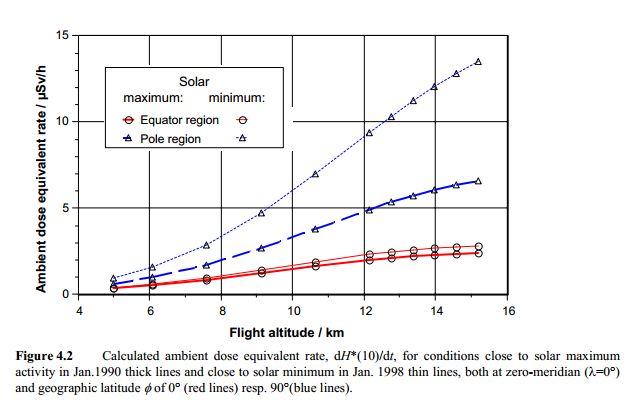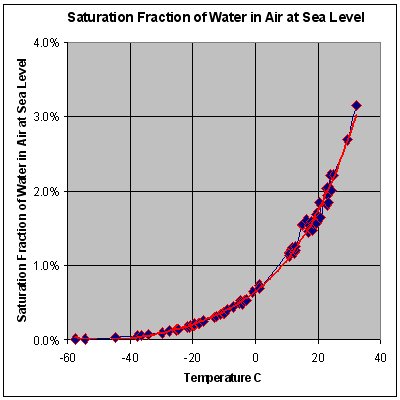#Atmosphere, surface temperature and other properties directly related to life
- **Magnetosphere:**
- Magnetospheres are thought to be driven by a dynamo process driven by internal circulation in the molten core of the planet, are are very useful in protecting the planet from DNA-damaging ionic particles in stellar wind, and helps prevent accelerated atmospheric loss. (eg. Mars)
- Magnetosphere acts like a cut-off filter - stopping cosmic rays below a certain energy, or "vertical cut-off rigidity." It's ~17 GeV at the equator, and <1 GeV at the poles. Cosmic rays are 0.39 mSv/year on surface, but not a lot of shielding happens from the magnetosphere.
- http://www.nasa.gov/centers/langley/science/polar-radiation.html
- http://sol.spacenvironment.net/~nairas/Dose_Rates.html
- **Atmosphere:**
- Atmosphere is regulated by gravity, denser/more gravity, more original atmosphere kept.
- Kármán line is where flight speed (density of air) equals orbital velocity (Earth == 100km)
- Current Composition:

- (at standard pressure/temperature):
- Too much Carbon Dioxide: CO2 displaces oxygen. Earth has .0035%, OSHA limits 8hr work day to 5,000 ppm (.5%) - a 30-minute exposure to 50,000 ppm produces intoxication, and concentrations greater than that (7-10%) produce unconsciousness. [High concentrations produce acidosis](http://www.blm.gov/style/medialib/blm/wy/information/NEPA/cfodocs/howell.Par.2800.File.dat/25apxC.pdf). Hypercapnia. Under concentrated conditions, plant roots can actually be suffocated by carbon dioxide.
- Too little Carbon Dioxide: Trace amounts (parts per million) regulate blood pH, and perform a few other vital roles. [Autoregulation](http://gayyoga.gn.apc.org/Respiration.htm) of breathing (but perhaps this is compensated for by generation of CO2 in our lungs?)
- Non-trivial amounts of Oxygen in the atmosphere are typically waste byproducts of photosynthesis with CO2 and solar energy. Life is not *required* (but see improbable below) to produce oxygen in the atmosphere: eg: if titania covers .05 of the surface of an Earth-like planet (with a Sol-like star), in conjunction with water it can produce enough oxygen; 3% surface area with a dimmer star.
- Too much oxygen: Oxygen toxicity is a condition resulting from the harmful effects of breathing molecular oxygen (O2) at elevated partial pressures. Hyperoxia. Increased free radicals. Lung damage (inflammation; several days). Fires burn better. At 30% O2, humans (especially hair and fat) become about as combustible as a paraffin torch. Static electricity = boom. Wet vegetation will burn (at 30%) and lightning/falling rocks/wildfires will take out any available fuel. Other environmental effects; animals, microorganisms, rust, ozone, bleaching, etc. Once you hit the O2 compensation point, plants stop photosynthesizing.
- Too little oxygen: breathing an oxygen deficient atmosphere can have serious and immediate effects, including unconsciousness after only one or two breaths. An exposed human has no warning and cannot sense that the oxygen level is too low. With an atmospheric oxygen level of 11-18%, it results in the reduction of physical and intellectual performance without the sufferer being aware. At 8-11% the possibility of fainting within a few minutes without prior warning. Risk of death below 11%. At 6-8%, fainting occurs after a short time. Resuscitation possible if carried out immediately. At 0-6%, fainting almost immediate; with brain damage, even if rescued.
- Too new oxygen: If oxygen hasn't been around on the planet long enough, it will react with exposed iron and other elements (oxidation/rust) and reduce from the atmosphere/oceans forming banded ironstone formations - magnetite (Fe3O4) / hematite (Fe2O3), alternating with bands of iron-poor shales and cherts. This reduction took (300 million/1 billion?) years on Earth. Oxygen reacts with non-sequestered Carbon, forming CO2. Reacts with loose Hydrogen = water.
- Ozone layer, formed of Oxygen, protects life from solar radiation, without which it's difficult for life to gain a foothold.
- Too much Xenon: It passes the blood/brain barrier and is used for anesthesia.
- Too little Nitrogen: and there will be no nitrates formed in the soil.
- Physically Impossible Combinations: (i.e. 'Hindenburg' H2 O2 atmospheres - forms water when shocked, eg: static electricity from atmospheric movement like lightning)
- Physically Improbable Combinations
- O2 atmosphere without life (bacteria, most likely).
- Pre-vascular plants operating on dry land change rock breakdown into clays, which sequesters carbon freed up by photosynthesis - raising the O2 percentage in the atmosphere, thus [allowing proliferation of higher multicellular lifeforms](http://www.nature.com/nature/journal/v460/n7256/full/nature08213.html) (see also [here](https://www.scientificamerican.com/article/origin-of-oxygen-in-atmosphere/))
- Low Nitrogen atmosphere (you will need a good excuse to selectively remove/fixate the typically vast amount of Nitrogen available in accretion materials)
- **Too-dense atmosphere**
- Earth surface pressure is 100kPa, Venusian pressure (9.2 MPa) is almost 100 times higher (but Venus' mass is lower; 4.868 vs Earth's 5.9736), while Martian pressure (600 Pa) is over 100 times lower. So you'll need a reason to lose a portion of the default atmosphere, or face run-away greenhouse effects as well as the physiological issues below.
- **Atmosphere loss**
- impact-loss (Mars)
- w/o magnetosphere: sputtering, photodissociation (Mars)
- because of magnetosphere: polar wind, charge-exchange
- Jeans escape
- Moon-skimming removes some atmosphere
- **Gaining/Keeping an Atmosphere**
- Gravity/size/density regulates retention
- Gain from ice impact; hydrogen can be removed after disassociation, leaving oxygen (how much ice is in your solar system?)
- Outgassing from original accretion material, from the planet's interior
- **Atmospheric Pressure**
- Pressure is too low: At 2,100 m above sea level on Earth, the saturation of oxyhemoglobin begins to plummet - short and long-term adaptations allow humans to go up to about 8,000 m [less than 356 millibars of atmospheric pressure], where no adaptations help (ie: "Death zone"). Sleeping becomes difficult, food digestion impossible with potentially fatal high altitude pulmonary edema (HAPE) and high altitude cerebral edema (HACE) becoming more common. Humans have survived for two years at 5,950 m [475 millibars of atmospheric pressure], which is the highest recorded permanently tolerable highest altitude; the highest permanent settlement known, La Rinconada, is at 5,100 m. Increased suicide rate (no known cause).
- [Armstrong limit](https://en.wikipedia.org/wiki/Armstrong_limit): (on Earth ~18,900m) at 6.3 kPa, water boils at 37C: saliva from tongue, tears/water f/eyeballs, water off of alveoli.[(*)](https://web.archive.org/web/20141014072430/http://imagine.gsfc.nasa.gov/docs/ask_astro/answers/970603.html)
- Without supplemental breathing oxygen, the time for useful consciousness at 26,000 ft is 4-6min, at 30,000 ft; 1-2m, and at 38,000 ft; 30sec or less before the aviator succumbed to hypobaric hypoxia. At <1psi unconsciousness occurs at ~14s, length of time it takes for blood to go from lungs to the brain.
- Pressure is too high: Aseptic bone necrosis (long-term). Respiratory acidosis (and ultimately toxicity) (CO2), inert gas narcosis (N2), oxidative stress (O2), High Pressure Nervous Syndrome (HPNS) which occurs beyond 10-15 ATA. Specially trained and equipped (read: very specific, non-natural (helium, non-nitrogen) gas mixes, etc) humans have survived 70 ATA for limited periods of time.

- Affects the boiling and evaporation points of all sorts of chemicals.
- **Oceanic Tides**
- Tides are proportional to mass / distance^3 (Earth: Solar tides are about 45% those of Lunar tides (interact as Spring or Neap tides)). Geography impacts the severity of these baselines on actual coastlines. More moons == more tidal problems; cancellation, exaggeration, very complex tide tables.
- Tides, and tidal pools, may be responsible for mixing chemicals (and environments for them to flourish) which may have contributed to the evolution of life.
- **Radiation**
- 5 and 6 Sieverts (Sv) over the course of a few minutes will shred up too many cells for your body to fix at once.
- Even Earth normal background radiation will cause cancer within 4,000 years.
- Even being at high altitude on Earth will [increase cataracts.](https://scienmag.com/chernobyl-three-decades-on/)

- **Surface temperature range:**
- Too hot: Hyperthermia. Death after 10m in extremely humid (ie: no sweating) 60C heat.
- Too cold: Hypothermia. Death after core temp reaches 21C - but acclimatization, etc. all impact when this point occurs. Also; special type of hibernation.
- NASA (1958) says indefinite survival at 4-35C / 50% humidity. Somewhat higher temps can be handled if humidity is decreased, and water intake is plentiful.
- Core temperature loss is greatly enhanced by wind / sweat evaporation.
- **Volatiles: (water) / Must have Water**
- Water is required to breathe (alveoli, air exchange). At rest, loss rates from breathing alone range from at least 7-20 ml/h, exercise at 140bpm heart-rate is 60–70 ml/h (depending on temperature and humidity). If you're breathing, you *will* lose water.
- Heat regulation: Sweating occurs when over-heated compared to environmental temperature; humans can sweat when in cold conditions if exercising. If you're working (hunting, farming, most gathering), you will almost always sweat.
- Urination: elimination of bodily wastes uses water. Consistent lack of urination will lead to build up of toxins, liver and other organ failure.

- **Must have Food**
- Base of the food chain are typically "plants", which convert energy (solar (chlorophyll), geothermal heat) to chemical energy.
- Nutrients / Micronutrients (needed from diet: biotin, calcium, choline, chromium, copper, fiber, flavonoids, folate, iodine, iron, magnesium, manganese, omega-3 fatty acids, pantothenic acid, phosphorus, potassium, protein, salt, selenium, vitamin A, vitamin B1 - thiamin, vitamin B12 - cobalamin, vitamin B2 - riboflavin, vitamin B3 - niacin, vitamin B6 - pyridoxine, vitamin C, vitamin D (supplemental), vitamin E, vitamin K, zinc) otherwise various disorders.
- Humans don't produce all the amino acids they need to live.
- Caloric intake varies on lifestyle, age, and gender/size/lean body mass (amongst other factors):
- adult males: 2,000-2,600 sedentary, 2,200-2,800 moderately active, 2,400-3,000 active.
- adult females: 1,600-2,000 sedentary, 1,800-2,200 moderately active, 2,000-2,400 active.
- **Plants are typically grown in soil**
- Incorrect atmosphere leads to inhospitable soil conditions https://scienmag.com/researchers-explore-possibilities-of-growing-plants-on-mars/